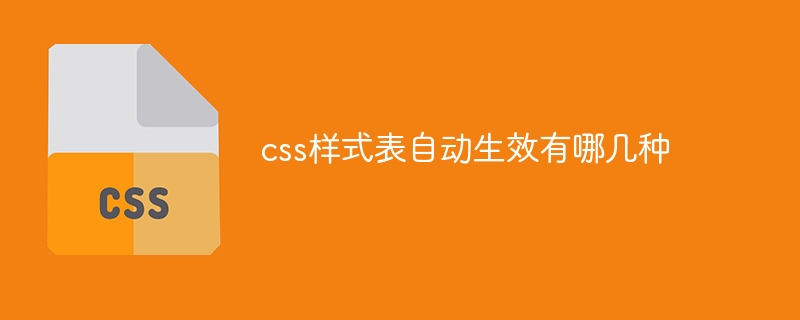 Web Front-end
Web Front-end
 CSS Tutorial
CSS Tutorial
 What are the types of css style sheets that automatically take effect?
What are the types of css style sheets that automatically take effect?
What are the types of css style sheets that automatically take effect?
There are five ways for CSS style sheets to automatically take effect: 1. Direct inline styles; 2. Internal style sheets; 3. External style sheets; 4. Attribute selectors; 5. JavaScript.

Several ways for CSS style sheets to automatically take effect
There are several ways for CSS style sheets to automatically take effect:
1. Direct inline style
Inline style is written directly in the <style> tag of the HTML element. It is only effective for the element that contains it and takes precedence over other styles.
<p style="color: red; font-size: 20px;">一些文本</p>
2. Internal style sheet
The internal style sheet is written in the <style># inside the
tag. ## tag. It is effective for the entire page and takes precedence over external style sheets. <head>
<style>
p {
color: blue;
font-size: 16px;
}
</style>
</head>3. External style sheet
The external style sheet is an independent file, and its file name has the extension.css. Link it to the HTML page via the tag. Has lower priority than internal style sheets.
<head> <link rel="stylesheet" href="style.css"> </head>
4. Attribute selector
Attribute selector matches elements with specific attributes. When an element has this attribute, the style will automatically take effect. For example, the following style will apply red text to all elements withclass="important":
[class="important"] {
color: red;
}5. JavaScript
Using JavaScript CSS styles can be applied dynamically. For example, the following code will add aclass to the element, making its text red:
document.getElementById("myElement").classList.add("important");The above is the detailed content of What are the types of css style sheets that automatically take effect?. For more information, please follow other related articles on the PHP Chinese website!

Hot AI Tools

Undresser.AI Undress
AI-powered app for creating realistic nude photos

AI Clothes Remover
Online AI tool for removing clothes from photos.

Undress AI Tool
Undress images for free

Clothoff.io
AI clothes remover

AI Hentai Generator
Generate AI Hentai for free.

Hot Article

Hot Tools

Notepad++7.3.1
Easy-to-use and free code editor

SublimeText3 Chinese version
Chinese version, very easy to use

Zend Studio 13.0.1
Powerful PHP integrated development environment

Dreamweaver CS6
Visual web development tools

SublimeText3 Mac version
God-level code editing software (SublimeText3)

Hot Topics
 How to draw a specific shape with an orange background color using CSS' clip-path property?
Apr 05, 2025 pm 04:36 PM
How to draw a specific shape with an orange background color using CSS' clip-path property?
Apr 05, 2025 pm 04:36 PM
Practical application cases of CSS drawing function In modern web design, CSS can not only be used for layout and style, but also for creating complex graphics and animations. May...
 How to add loading animation to the a tag click and then jump?
Apr 05, 2025 pm 04:48 PM
How to add loading animation to the a tag click and then jump?
Apr 05, 2025 pm 04:48 PM
Cleverly implementing the short animation and jump after clicking the a tag, many times, we hope that after clicking the a tag, the page can first display a short loading event...
 What are the encoded fonts used in the picture? How to apply this font style in a project?
Apr 05, 2025 pm 05:06 PM
What are the encoded fonts used in the picture? How to apply this font style in a project?
Apr 05, 2025 pm 05:06 PM
Introduction and use of encoded fonts In programming and web design, choosing the right font can greatly improve the readability and aesthetics of the code. recent,...
 How to customize the hover effect of merge rows in el-table?
Apr 05, 2025 pm 06:54 PM
How to customize the hover effect of merge rows in el-table?
Apr 05, 2025 pm 06:54 PM
How to customize the hover effect of merge rows in el-table? Using Element...
 How to elegantly achieve high adaptability of the middle content in the three-line layout?
Apr 05, 2025 pm 04:39 PM
How to elegantly achieve high adaptability of the middle content in the three-line layout?
Apr 05, 2025 pm 04:39 PM
Discussion on the height of adaptive intermediate content in three-line layout In web layout, you often encounter the need to implement three-line layout and the intermediate content is highly variable...
 What is the
What is the What are the elements in CSS for? During the learning and using CSS, you may encounter some less common HTML elements, such as <...
 How to use locally installed 'Jingnanmai Round' on a web page without loading the font file?
Apr 05, 2025 pm 04:54 PM
How to use locally installed 'Jingnanmai Round' on a web page without loading the font file?
Apr 05, 2025 pm 04:54 PM
How to use locally installed font files on web pages In web page development, sometimes we will encounter the situation where we need to use specific fonts installed on our computer...
 How to customize the hover effect of merged rows in el-table of Element UI?
Apr 05, 2025 pm 03:24 PM
How to customize the hover effect of merged rows in el-table of Element UI?
Apr 05, 2025 pm 03:24 PM
How to customize the el-table merge hover effect when using Element...





